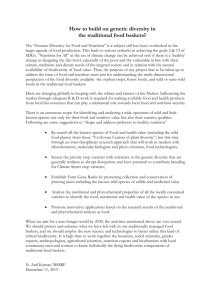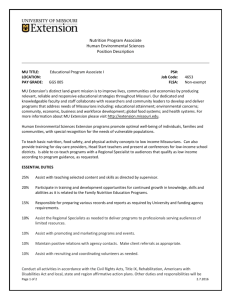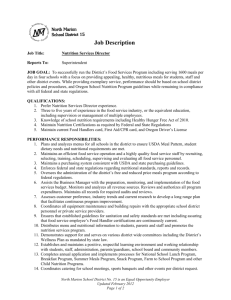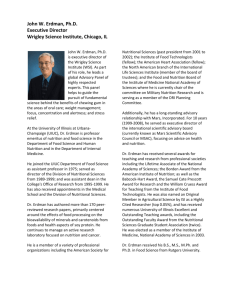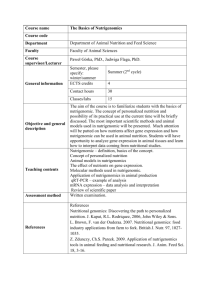Supplementary Table 2 (docx 23K)
advertisement
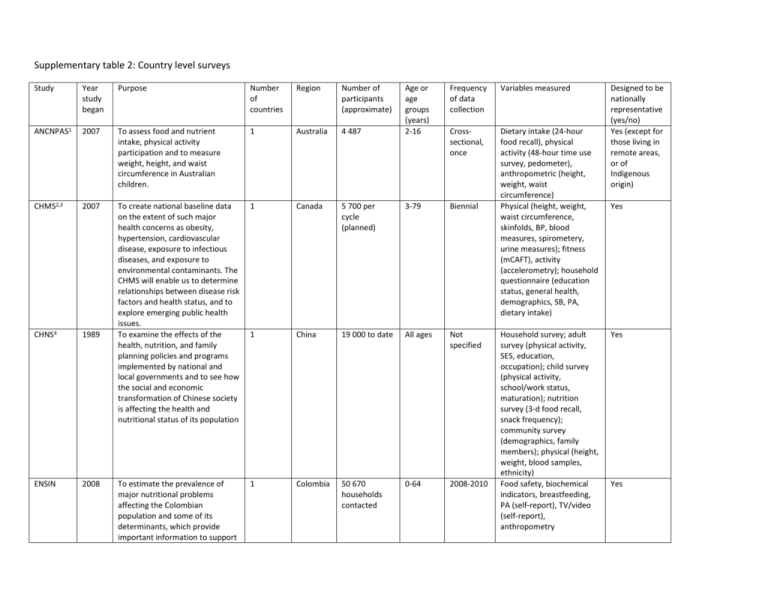
Supplementary table 2: Country level surveys Study Year study began Purpose Number of countries Region Number of participants (approximate) Age or age groups (years) 2-16 Frequency of data collection Variables measured ANCNPAS1 2007 To assess food and nutrient intake, physical activity participation and to measure weight, height, and waist circumference in Australian children. 1 Australia 4 487 Crosssectional, once 5 700 per cycle (planned) 3-79 Biennial Dietary intake (24-hour food recall), physical activity (48-hour time use survey, pedometer), anthropometric (height, weight, waist circumference) Physical (height, weight, waist circumference, skinfolds, BP, blood measures, spirometery, urine measures); fitness (mCAFT), activity (accelerometry); household questionnaire (education status, general health, demographics, SB, PA, dietary intake) CHMS2,3 2007 1 Canada CHNS4 1989 To create national baseline data on the extent of such major health concerns as obesity, hypertension, cardiovascular disease, exposure to infectious diseases, and exposure to environmental contaminants. The CHMS will enable us to determine relationships between disease risk factors and health status, and to explore emerging public health issues. To examine the effects of the health, nutrition, and family planning policies and programs implemented by national and local governments and to see how the social and economic transformation of Chinese society is affecting the health and nutritional status of its population 1 China 19 000 to date All ages Not specified ENSIN 2008 To estimate the prevalence of major nutritional problems affecting the Colombian population and some of its determinants, which provide important information to support 1 Colombia 50 670 households contacted 0-64 2008-2010 Household survey; adult survey (physical activity, SES, education, occupation); child survey (physical activity, school/work status, maturation); nutrition survey (3-d food recall, snack frequency); community survey (demographics, family members); physical (height, weight, blood samples, ethnicity) Food safety, biochemical indicators, breastfeeding, PA (self-report), TV/video (self-report), anthropometry Designed to be nationally representative (yes/no) Yes (except for those living in remote areas, or of Indigenous origin) Yes Yes Yes HBSC5 1982 MSC6 NHANES7 policy making To gain new insight into, and increase our understanding of young people’s health and wellbeing, health behaviours, and their social context 43 Multi-disciplinary research project following the lives of children born in the U.K. between 20002002. It is the most recent of Britain’s national birth cohort studies. 1999 To assess the health and nutritional status of adults and children in the United States 1 Europe, Canada, U.S. 4 500 per country (planned) 11, 13, 15 Crosssectional, every 4 years U.K. (England, Scotland, Wales, Northern Ireland) 18 818 singleton children 7-8 U.S. 5 000 per cycle (planned) >2 Cohort with data collection at ages 9months, and 3, 5, 7, 11, 14 years Biennial Background (demographics and maturation); social (family structure, SES); individual and social resources (body image, family support, peers, school environment); health behaviours (PA, diet, smoking, alcohol, cannabis, sexual behaviour, violence, bullying, injuries); health outcomes (symptoms, life satisfaction, self-reported health, BMI) Social demographic (homebased interview), child’s age, gender, ethnicity, maternal occupation, family structure, country of residence; accelerometer measured physical activity and sedentary behaviour. Family questionnaire (demographic background, occupation, housing, smoking, consumer behaviour, income, food security); sample person questionnaire (demographics, physical measurements, occupation, health care usage, PA/fitness); diet (24-hr food recall); PA (accelerometer) No Yes Yes ANCNPAS: Australian National Children's Nutrition and Physical Activity Survey; CHMS: Canadian Health Measures Survey; CHNS: China Health and Nutrition Survey; ENERGY: EuropeaN Energy balance Research to prevent excessive weight Gain among Youth; ENSIN: Encuesta Nacional de la Situación Nutricional (National Survey of Nutritional Status); EYHS: European Youth Heart Study; IDEFICS: identification and prevention of dietary- and lifestyle induced health effects in children and infants; HBSC: Health Behaviour in School-aged Children; HELENA: Healthy Lifestyle in Europe by Nutrition in Adolescents; MSC: Millennium Cohort Study; NHANES: National Health and Nutrition Examination Survey. *A study was deemed nationally representative if it was stated as such on the study website, or published protocol and/or explicit details on weighting of participants demographics was provided References 1 Department of Health and Ageing. Australian National Children’s Nutrition and Physical Activity Survey (ANCNPAS): main findings. Commonwealth Scientific and Industrial Research Organisation (CSIRO) and the University of South Australia: Canberra, Australia, 2008. 2 Tremblay M, Wolfson M, Connor Gorber S. Canadian Health Measures Survey: rationale, background and overview. Health Rep 2006; 18 Suppl: 7–20. 3 Giroux S. Canadian Health Measures Survey: sampling strategy overview. Health Rep 2006; 18 Suppl: 31–36. 4 Tudor-Locke C, Ainsworth BE, Adair LS, Du S, Popkin BM. Physical activity and inactivity in Chinese school-aged youth: the China Health and Nutrition Survey. Int J Obes 2003; 27: 1093–1099. 5 Currie C, Zanottie C, Morgan A, Currie D, de Looze M, Roberts C et al. Social determinants of health and well-being among young people. World Health Organization: Copenhagen, WHO Regional Office for Europe, 2012. 6 Griffiths LJ, Cortina-Borja M, Sera F, Pouliou T, Geraci M, Rich C et al. How active are our children? Findings from the Millennium Cohort Study. BMJ Open 2013; 3: e002893. 7 Center for Disease Control and Prevention. National Health and Nutrition Examination Survey. National Center for Health Statistics.


